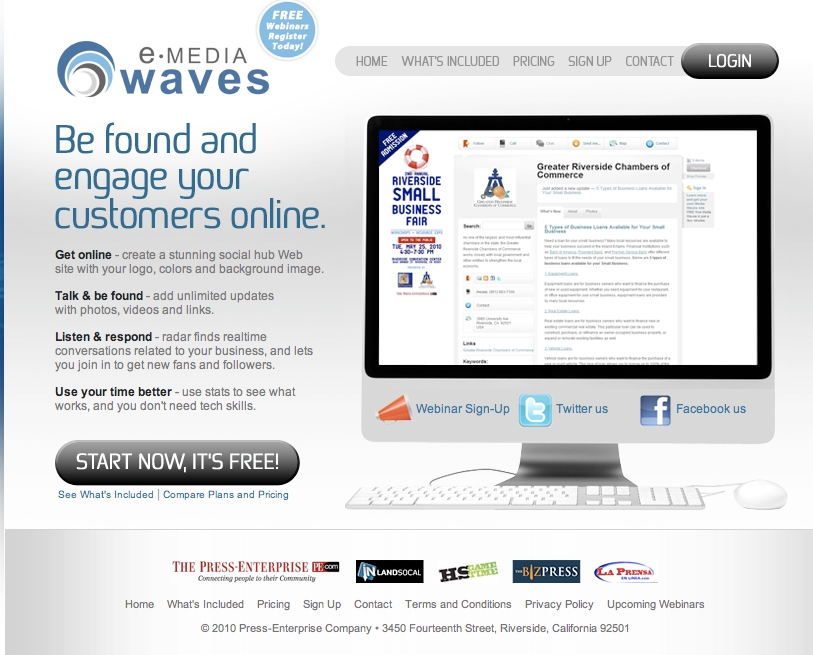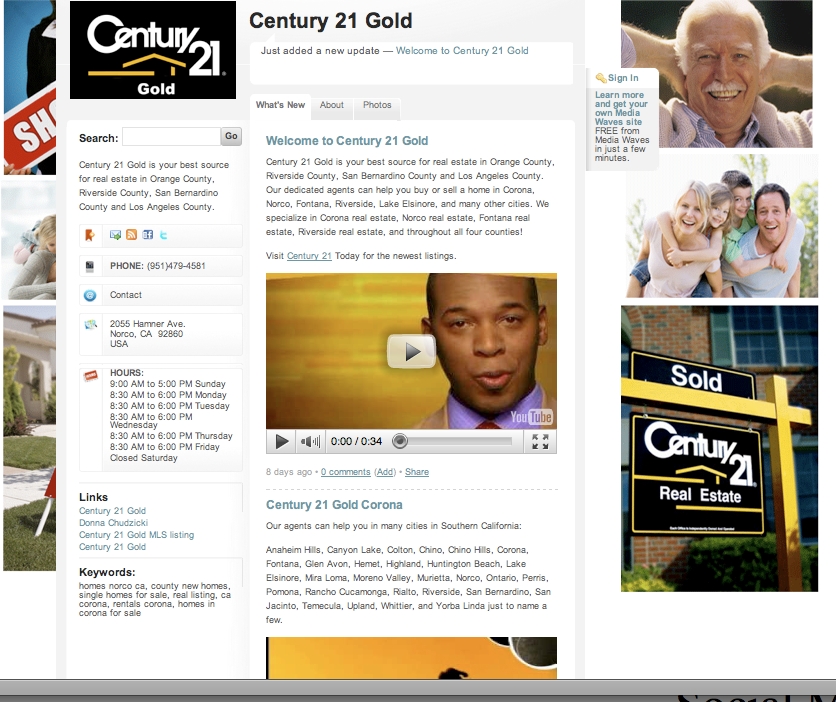How Riverside Press has positions eMedia Waves to help sell social media services
New service: eMediaWaves.com
Company: Riverside Press Enterprise, PE.com
Market: Inland Empire area in Southern California
Owner: A.H. Belo
Key executive: Andrew McFadden, manager of Digital Innovation and Business Development
Summary: Local media sales of social media services that generate blogs and populate Facebook fan pages are just getting off the ground. The Riverside Press-Enterprise in California is unique in that it is providing a self-serve platform, in addition to full service. The company got into the game early on, signing up with third-party technology provider SMBLive just before its sale to Reach Local. Today the P-E sells e-Media Waves, the white label version of the original Cloudprofile platform created by SMBlive.
The Profiles are blog sites with a bevy of cool social media features baked in, which can be created on a DIY basis. Andrew McFadden, Manager of Digital Innovation for the P-E, said the name was chosen to express how information ripples outward in waves from the original profile.
Here's how the project got off the ground and early results:
Challenge: Like many digital managers, McFadden saw phenomenal numbers on Facebook growth and usage by small businesses. He wanted to create social media services that small businesses would be able to easily use and which could be up-sold to additional services and media. Publisher Ron Redfern was also supportive of a DIY model, hoping the newspaper site could reach more deeply into the small business marketplace.
“As the local media company, there is an opportunity to be the trusted expert in social media and social media marketing,” says McFadden. “Unlike any other advertising service, social media is about creating interesting headlines and relevant content that attracts attention and readers; who knows how to do that better than local media companies?”
Strategy: McFadden began with a simple concept; the social media platform needed to solve the problem of "I know I need to be on Facebook, but I don’t know how to do it." He and a team of sales managers worked through a pre-launch strategy.
1. Identifying the software platform
To build social-media software from scratch is possible using an open-source WordPress Multi-user platform, with modules that push information to Facebook and Twitter, as well as other functions.
But SMBLive has the advantage of being turnkey system with the bugs worked out. Like Cloud Profiles, the white label version is a friendly, well-designed interface for people who are not experts. SMBLive is also fully supported at the retail level.
“One of the key benefits we saw in working with SMBLive was that they would handle all tier-one and tier-two technical support, including a one-hour training for new clients and on-going email and web-to-chat support for existing clients."
Click-to-Call, Click-to-Chat, Google Maps and text messaging are pre-installed and standard to each profile. In addition to automatic updates to Facebook and Twitter, advertisers can embed any of the above mentioned services (Click-to-Chat and Maps are popular) "everywhere," including the advertiser’s web site, by selecting additional locations from a drop down window. With these features enabled the owner/manager only has to update a key phone number once and the information is automatically updated across the web.
McFadden says the service is ideal for businesses who don't know how to update their web site themselves, or lack interactive support.
2. Surveying the local marketplace
To understand the social media usage of the most likely group of local customers, McFadden's team also conducted an online analysis of about 1000 of its advertisers from the past three months. The team of three people in the digital innovation department surveyed and recorded a number of key factors in each business's web presence including:
• Facebook presence and number of fans
• Whether they had a Twitter account and how popular it was
• What page the site showed up on Google when the company name was searched
(To see a copy of the form, please go here). The analysis showed how many businesses needed extra services - a lot - and as a side benefit the report can be used as leads for sales people and managers.
3. An internal audit of social media competency
McFadden also conducted an internal audit (attached)of the Press-Enterprise to find its social media champions on the four sales teams, in addition to asking managers to select their leaders. Sales Leaders were asked to choose three clients each for the pilot program, for a total of twelve, which later got honed down to nine.
4. 90 day test period
By March, the sales leaders selected had met with their selected clients to launch the initial pilot program; their nine companies posted profiles on the system for ninety days for free. McFadden said he quickly determined that many of the companies wanted support in posting blogs and managing the program, even with the simplified tools. Some sales reps went over-board, offering to create passwords and log in for their clients, while others stayed at a greater distance, but clearly there was a market for supported accounts!
5. Official launch
At the end of the quiet period, eMedia Waves officially launched with both self-serve and supported accounts June. Self-serve accounts are free for 30 days and then cost $50 a month. Full-service offerings starting at $500 per month and include creating a Facebook Page, Twitter Page, and creating brief posts on the blog site that syndicate to the social networks.
Results: Between June and mid-July the company acquired about 10 to 12 full service clients and has 50 self-service clients running on a 30-day trials. The DIY side of the business has not been has successful as the full service accounts.
Lessons learned:
•Social media profiles can either replace or supplement company web sites that do not have these tools.
•As a service, selling blogs requires some SEO skills. Writers find simple key words that customers are searching for and incorporate them into blog headlines. For example, a real estate company may only have only one foreclosure listing, the most searched real estate term. However, the blogger may create a headline such as "Why foreclosure sales may not be worth it" that gains SEO rankings and generates qualified leads.
• Analyzing the online strategies of the top 1000 or so advertisers is a great method of both gauging opportunities in the marketplace and providing a source of leads for online business development. Here's a sample survey to use.
• Find the social media champions in your company. Here's a copy of McFadden's internal audit as a starting point to assess who is a heavy social media user.
• Selling a social media platform is only part of an overall "bundle."
Thanks to Andrew McFadden and the Riverside Press-Enterprise for sharing this case study. If your media company has a successful revenue initiative please send an email to alisacromer@gmail.com.

The author, Alisa Cromer is publisher of a variety of online media, including LocalMediaInsider and MediaExecsTech, developed while on a fellowship with the Reynolds Journalism Institute and which has evolved into a leading marketing company for media technology start-ups. In 2017 she founded Worldstir.com, an online magazine, to showcases perspectives from around the world on new topic each month, translated from and to the top five languages in the world.









